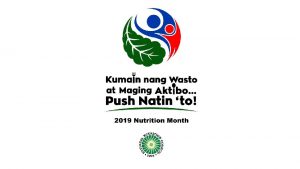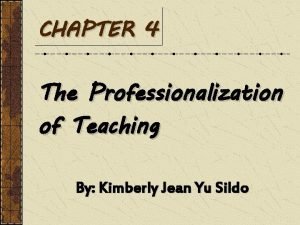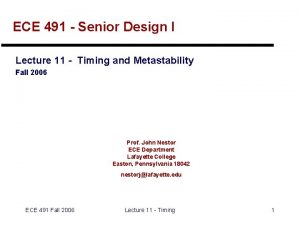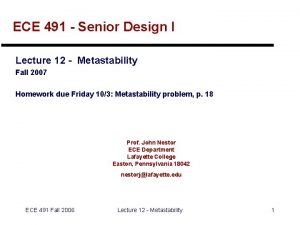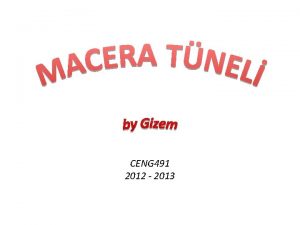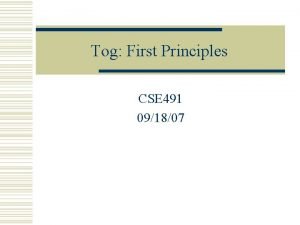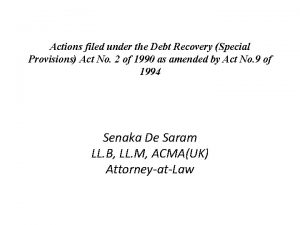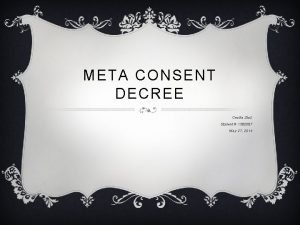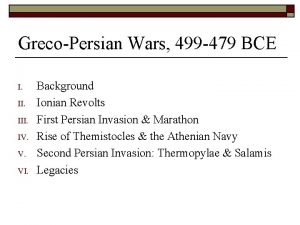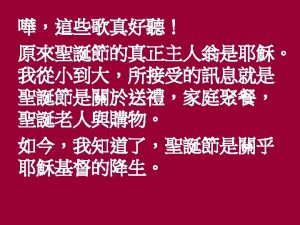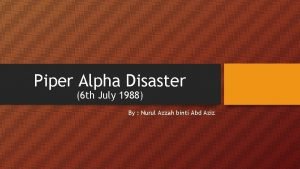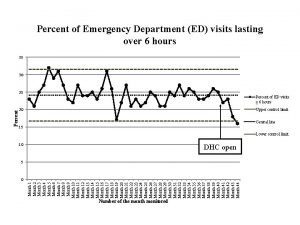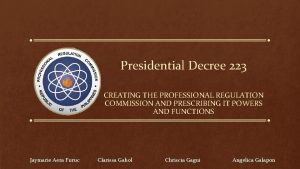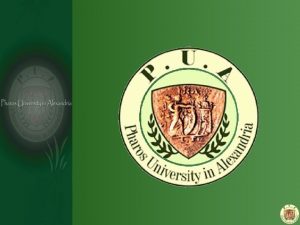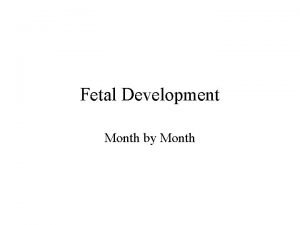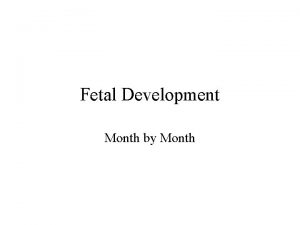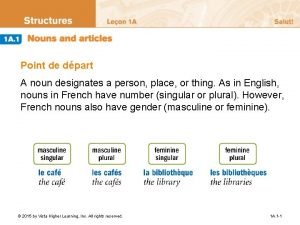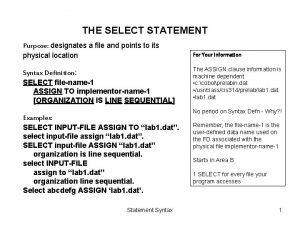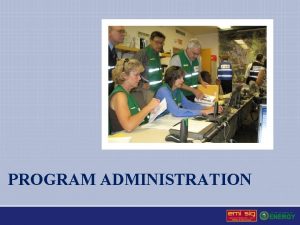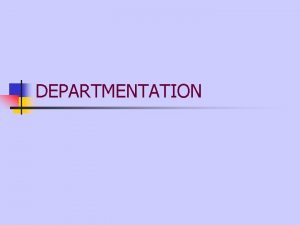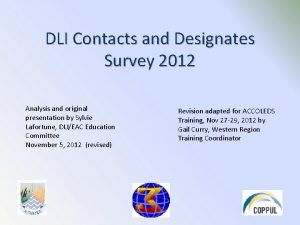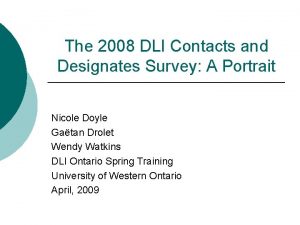Presidential Decree 491 Designates July as Nutrition Month





































- Slides: 37


Presidential Decree 491 • Designates July as Nutrition Month for the purpose of creating greater awareness among our people on the importance of nutrition • Mandates the NNC to coordinate activities of Nutrition Month

2019 Nutrition Month Theme

Physical Activity defined as any bodily movement produced by skeletal muscles that requires energy expenditure.

AEROBIC MUSCLESTRENGTHENING BONESTRENGTHENING STRETCHING

Exercise • Form of physical activity that is planned, structured, repetitive, and purposive • Performed during leisure time with the primary purpose of improving or maintaining physical fitness, physical performance, or health

Benefits of physical activity Prevent NCDs Weight management Muscle and bone strength Better sleep Mental health Savings

Physical Inactivity vs Sedentary Behavior • refers to a level of activity that is lower than that required to maintain good health or lower than the recommended guidelines • any waking behavior characterized by an energy expenditure ≤ 1. 5 MET • Involves prolonged sitting or lying down

Sedentary Behavior • Associated with increased risk for obesity, metabolic syndrome, type 2 diabetes, and CVD mortality • Independent factor for poor health • Even among individuals who meet current physical activity guidelines, high levels of sedentary activity might lead to negative health outcomes

Consequences of Physical Inactivity Weight gain NCDs Disability Healthcare expenditure Decreased Productivity Death

Healthy Diet • At least 400 grams of vegetables and fruits per day excluding starchy roots • <10% of total energy intake from free sugars • <30% of total energy intake from fats with <10% of total energy intake from saturated fats and <1% of total energy intake from trans-fats • <5 grams of salt (one teaspoon) intake per day

Physical Activity and Healthy Diet • Maintain normal body mass index (BMI) • Management of certain diseases like diabetes and heart disease • Having a healthy meal plan and being active helps keep one's blood glucose level, blood pressure and cholesterol in a healthy range • Healthy diet may have a stronger effect on weight loss than physical activity • Physical activity has a stronger effect in preventing weight regain after weight loss

Insufficiently Physically Active Adults Source: Expanded National Nutrition Survey 2018, FNRI-DOST

Reasons for Physical Inactivity: Personal lack of time lack of selfmotivation inconvenience non-enjoyment lack of confidence lack of social network fear of high cost Injury or fear of injury lack of commitment lack of goals lack of support Limited knowledge

Reasons for Physical Inactivity: Environmental non-availability or inaccessibility of parks, sidewalks, bicycle trails and similar infrastructure or facilities lack of or unsuitable programs crime or violence Lack of community spirit pollution

Philippine National Guidelines on Physical Activity (PNGPA): Children, 5 -12 years At least 60 minutes daily consisting of any one or a combination of the following physical activities: • Active tasks - active travel, daily tasks • Exercise, dance or sports – programmed physical activity for 20 -30 minutes daily • High impact play (unstructured spontaneous play) on most, if not all, the days of the week – running, jumping, hopping, skipping, indigenous games, playground activities such as jungle bars and ropes

Philippine National Guidelines on Physical Activity (PNGPA): Adolescents to young adults, 13 -20 years At least 60 minutes of daily physical activity consisting of any one or a combination of the following physical activities: • Active daily task – active travel and daily tasks • Exercise, dance or sports – at least 40 minutes of programmed physical activities For fitness goals, should have continuous 2030 minutes minimum for at least 3 -5 x a week • High impact play– at least 20 minutes of sustained moderate to vigorous physical activities resulting in rapid breathing • Muscle strengthening and flexibility activities – at least 2 -3 x a week

Philippine National Guidelines on Physical Activity (PNGPA): Adults, 21 -45 years Accumulate 30 to 60 minutes of daily physical activity consisting of any one or a combination of the following activities: • Activities for daily living – active travel daily tasks • Exercise, dance and recreational activities – moderate intensity aerobic physical activity resulting in a noticeable increase in heart rate and breathing (still able to carry on normal conversation) done continuously for a minimum of 30 minutes or accumulated bouts of 10 minutes or longer

Philippine National Guidelines on Physical Activity (PNGPA): Adults, 21 -45 years • Muscle strengthening and flexibility activities – perform activities at least twice a week, on non-consecutive days. • Activities in the workplace – employees should have opportunities to be active at work and through activities organized, with provision of necessary facilities and/or equipment, by their workplace. Two-minute physical activities for every hour of sitting is highly encouraged.

Philippine National Guidelines on Physical Activity (PNGPA): Older adults, 46 -59 years Accumulate at least 30 minutes daily physical activity consisting of any one or a combination of the following physical activities: • Activities for daily living – active travel and active daily tasks • Exercise, dance and recreational activities – moderate intensity aerobic physical activity done continuously for a minimum of 30 minutes or accumulated bouts of 10 minutes or longer.

Philippine National Guidelines on Physical Activity (PNGPA): Older adults, 46 -59 years • Muscle strengthening and flexibility activities – perform activities at least twice a week, on non-consecutive days • Balance and coordination – specific activities for balance and coordination 2 -4 days a week • Activities in the workplace – employees should have opportunities to be active at work and through activities organized, with provision of the necessary facilities and/or equipment, by their workplace. Two-minute physical activities for every hour of sitting is highly encouraged.

Philippine National Guidelines on Physical Activity (PNGPA): Young old, 60 -69 years Accumulate at least 30 minutes daily physical activity consisting of any one or a combination of the different types of physical activities: • Activities for daily living – active travel and active daily tasks • Exercise, dance and recreational activities – moderate intensity aerobic physical activity resulting in a noticeable increased heart rate and breathing (still able to carry on normal conversation) done continuously for a minimum of 30 minutes or accumulated bouts of 10 minutes or longer.

Philippine National Guidelines on Physical Activity (PNGPA): Young old, 60 -69 years • Muscle strengthening and flexibility activities – perform activities at least twice a week, on non-consecutive days. • Balance and coordination – perform simple but dynamic movements that challenge postural and positional stability 2 -4 days per week • Activities in the workplace –Two-minute physical activities (walking, stair climbing, stretching) for every hour of sitting is highly encouraged.

Philippine National Guidelines on Physical Activity (PNGPA): Middle old, 70 -79 years Accumulate at least 30 minutes daily physical activity consisting of any one or a combination of the different types of physical activities: • Activities for daily living – active travel and mild, easy daily tasks such as mild yard and garden work • Exercise, dance and recreational activities –Any rhythmic and continuous light physical activity that uses large muscle groups while standing independently or assisted, seated, reclined or lying down, done for a total of 30 minutes continuously, three times weekly or accumulated bouts of 10 minutes or longer.

Philippine National Guidelines on Physical Activity (PNGPA): Middle old, 70 -79 years • Muscle strengthening and flexibility activities – perform activities at least twice a week, on non-consecutive days. • Balance and coordination –Take up specific activities for balance and coordination 2 -4 days per week

Philippine National Guidelines on Physical Activity (PNGPA): Vintage old, 80 years and above Accumulate at least 30 minutes daily physical activity consisting of any one or a combination of the different types of physical activities: • Activities for daily living – active travel and mild, easy daily tasks • Exercise, dance and recreational activities – continuous and light intensity physical activity. Any rhythmic and continuous physical activity that uses large muscle groups while standing assisted, seated, reclined or lying down done for a total of 20 minutes continuously, three times weekly or accumulated bouts of 10 minutes or longer.

Philippine National Guidelines on Physical Activity (PNGPA): Vintage old, 80 years and above • Muscle strengthening and flexibility activities – perform resistance exercises at least twice a week, on non-consecutive days • Balance and coordination – perform simple but dynamic movements while standing or sitting on the exercise ball with a spotter. Take up specific activities for balance and coordination done at least three days per week.

The 10 guidelines of the PNGPA are as follows: 1. An evaluation of physical activity readiness must be made before engaging in any physical activity and clearance from a physician is recommended if you want to engage in more rigorous physical activity; 2. To ensure safety, clearance from a physician is also needed for people with illnesses that may contraindicate exercise; 3. If deemed healthy, exercise should progress slowly and within comfortable effort levels;

The 10 guidelines of the PNGPA are as follows: 4. Stop if dizziness, nausea, shortness of breath, and chest pains occur; 5. Reduce the intensity of the exercise or stop totally if there are physical or verbal manifestations of severe fatigue, cramps, and joint and muscle pains; 6. Keep a daily record of physical activity for monitoring; 7. For implementing personnel, allow the participant to stop when he requests at any point to do so;

The 10 guidelines of the PNGPA are as follows: 8. Drink 250 ml of fluid every 15 to 20 minutes of activity to ensure proper hydration; 9. Wear proper attire and footwear for thermal stress management and prevention of injuries; and 10. Allow ample recovery time after physical activities.

Integrating Physical Activity in Daily Routine At home • Involve the entire family in doing household chores • Give children toys that will promote physical activity • Regulate screen time of children to no more than 2 hours a day At school • Include activities that will enable children to move and learn at the same time • Encourage students to become active by ensuring safe playgrounds, holding sports clinics and schoolwide physical activity At work • Active transport • Form groups or clubs • enabling environment • policies

Ensuring Healthy Diet At home • Grow fruits and vegetables • Cook healthy foods for the family • Practice appropriate infant and young child feeding practices At school • Implement school policies that promote healthy diets • Grow fruits trees and vegetables • Advocate for sari-sari stores, food retailers, carinderias near school to sell healthy food options At work • Serve nutritious foods/snacks in the office cafeteria and during meetings and conferences • Conduct seminars/lectures on healthy diet

FRAMEWORK FOR ACTION: 4 Strategic Objectives

Ways to celebrate 2019 Nutrition Month • Hang streamers or posters about the celebration • Conduct seminars and other fora to discuss theme • Help promote and disseminate correct information on healthy diet and physical activity through print, social media, TV and radio programs, and other media

Ways to celebrate 2019 Nutrition Month • Conduct physical activities appropriate for intended audience • Participate in activities related to Nutrition Month celebration at the national, regional or local level • Conduct other activities that would highlight and promote healthy diet and physical activity

HAPPY NUTRITION MONTH! For more details: National Nutrition Council 2332 Chino Roces Avenue Extension Taguig City, Philippines http: //www. nnc. gov. ph www. facebook. com/nncofficial www. twitter. com/NNC_Official www. youtube. com/user/NNC 1974 info@nnc. gov. ph Tel. (632) 843 -0142 Fax. (632) 816 -4239

Thank you and happy Nutrition Month!
 Pngpa
Pngpa Professionalization of teaching
Professionalization of teaching Sidereal vs synodic moon
Sidereal vs synodic moon The month of abib
The month of abib What is a steady recurring pulse called
What is a steady recurring pulse called Ece 491
Ece 491 Ba 491
Ba 491 Ece 491
Ece 491 Ee 491
Ee 491 Ece 491
Ece 491 Cs 491
Cs 491 Ece 491
Ece 491 Ee 491
Ee 491 Ceng 491
Ceng 491 Cse 491
Cse 491 Ba 491
Ba 491 Tog 491
Tog 491 Luke triumphal entry
Luke triumphal entry Artaxerxes decree 444
Artaxerxes decree 444 Kiran atapattu vs pan asia bank
Kiran atapattu vs pan asia bank Artaxerxes decree 445
Artaxerxes decree 445 Meta consent decree
Meta consent decree Ye shall decree a thing
Ye shall decree a thing Themistocles decree
Themistocles decree Caesar augustus issued a decree that a census
Caesar augustus issued a decree that a census Based on the decree against profiteers answers
Based on the decree against profiteers answers Slidetodoc.com
Slidetodoc.com July 4 sermon
July 4 sermon May 1775
May 1775 July 26 1953
July 26 1953 July 12 1776
July 12 1776 July 10 1856
July 10 1856 Tender mean
Tender mean 2003 july 17
2003 july 17 July 14 1789
July 14 1789 Monday 13th july
Monday 13th july June too soon july stand by
June too soon july stand by I am silver and exact i have no preconceptions
I am silver and exact i have no preconceptions
